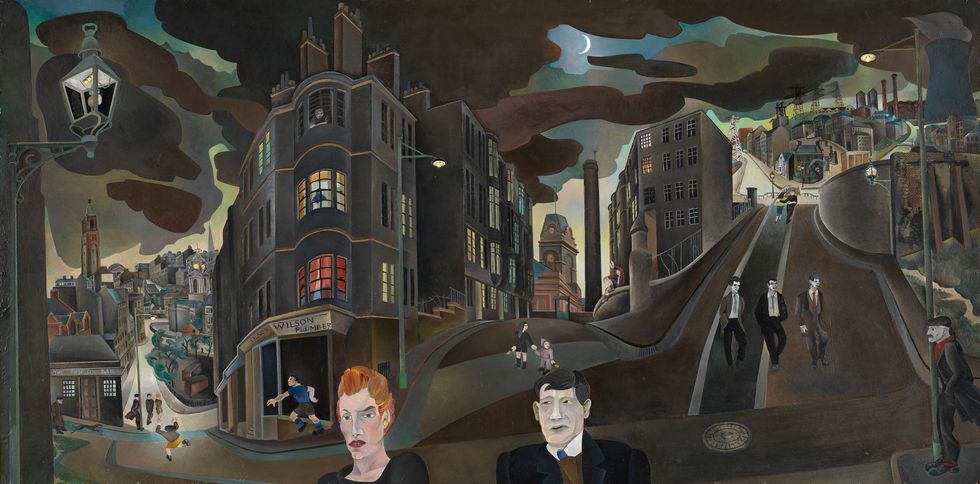
A mural by the late Alasdair Gray depicting post-war Glasgow will go on display at the gallery where the artist learnt to draw, after being acquired for the public.
Gray, a writer and artist, fondly recalled how childhood art classes at the Kelvingrove Art Gallery and Museum were one of the happiest times of his life.
He graduated from Glasgow School of Art in 1957 and was credited with sparking a “renaissance” for Scottish culture until his death in 2019.
Gray described the mural, Cowcaddens Streetscape In The Fifties, as “my best big oil painting”, and it is recognised as one of his most significant artworks.
Dating from 1964, the painting shows a hilly street at night surrounded by Victorian spires and industrial pylons, with tenement flats illuminated, and sharply dressed young men walking down the street.
It has been added to Glasgow Life Museums’ collection with help from the National Fund for Acquisitions, administered with Scottish Government funding by National Museums Scotland.
It was previously owned by Gray’s friend Angela Mullane.
Miss Jean Irwin held an art class on Saturday mornings in Kelvingrove. For the next five years, Saturday mornings were my happiest times
Alasdair Gray
The painting will be conserved at Glasgow Museums Resource Centre, where academics and fans will be able to see it through tours and research appointments.
It will then go on display at Kelvingrove Art Gallery and Museum, where Gray learnt to draw after his mother took him to classes there.
It was inspired by Garnethill and the canal near where the Alasdair Gray Archive is based.
Hand-painted shop signs and old-fashioned streetlights which still exist in Garnethill, a conservation area with connections to Charles Rennie Mackintosh, depict the city’s visual character.
It shows a city of changing demographics, with a parent chasing a child down the street, and an old man with a peaked cap taking his whippet for a walk outside a pub.
A couple can be seen walking with their arms around each other towards industrial Port Dundas in the north of the city, while St Aloysius Church in Garnethill can be seen to the south.
The painting, which measures more than two metres wide, is described as “bold and innovative in its use of altered perspective and time shift to portray the city and the stages of life of its inhabitants” by the estate of Gray.
It was a key part of Gray’s retrospective, From The Personal To The Universal, at Kelvingrove in 2014.
Speaking about the impact of the gallery on his life, Gray said: “I started making maps when I was small showing places, resources, where the enemy and where love lay.

“One day mum put some of my scribblings in a handbag and took me by tram to Kelvingrove.
“She had read in a newspaper that Miss Jean Irwin held an art class on Saturday mornings in Kelvingrove. I drifted around looking at what these kids painted while mum showed my scribbles to Miss Irwin, who let me join her class.
“For the next five years, Saturday mornings were my happiest times.”
Bailie Annette Christie, chair of Glasgow Life, said: “This painting is a remarkable addition to our collection of works by the legendary Alasdair Gray.
“It is a powerful image of Glasgow by an artist with strong links to the city and belongs in a public collection where Glaswegians and visitors can enjoy it.
“Acquisitions like this strengthen Glasgow’s world-class museum collections.
“They also help people to get involved in and feel inspired by the culture our city has to offer.”
Hazel Williamson, National Fund for Acquisitions manager, said: “We’re delighted to support the acquisition of this important work by Alasdair Gray, one of the most significant figures in Scottish art and literature during the post-war era.”
The Estate of Alasdair Gray said: “I am thankful for the city of Glasgow purchasing the Cowcaddens Streetscape on behalf of the citizens of Glasgow, Scotland and art lovers around the world.”
The Alasdair Gray Archive said: “This is Alasdair Gray’s most significant painting, and it is timely that it is now housed within the city’s main public galleries.”













